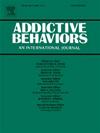青少年和年轻成年女性单一和多种物质使用的日常模式:日水平潜在类分析
IF 3.6
2区 医学
Q1 PSYCHOLOGY, CLINICAL
引用次数: 0
摘要
药物使用在青少年和青壮年(AYAs)中很普遍。与单独使用单一物质相比,使用多种物质的预后较差。然而,很少有研究调查了亚裔女性日常使用药物的模式及其相关因素。目的:1)确定AYA女性的日常物质使用模式,2)检查与选择的易感因素(如冲动和抑郁症状)和危险性行为的关系。方法选取15-24岁近期酗酒的女性样本(n = 149),在1个月的时间内(n天= 4224),通过每周时间线随访访谈报告每日药物使用和性行为。冲动、抑郁症状和社会人口统计学在基线时进行测量。进行日水平的潜在类别分析以表征物质使用模式,并使用Bolck, Croon和Hagenaars三步法来检查易感因素和其他健康行为与潜在类别成员的关联。结果确定了药物使用的4个日级别:1)很少使用到不使用(占54.1%);2)只吸电子烟(28.2%的天数);3)仅大麻(10.5%的天);4)酗酒和吸食大麻(一些人吸烟和吸电子烟;7.2%的天)。4级患者比1级和3级患者更易冲动(M = 0.42,分别为- 0.17和- 0.13),比1级和2级患者更易出现抑郁症状(M = 0.77,分别为- 0.19和0.01),比1级和2级患者更易在同一天发生无安全套性行为(M = 19%,分别为8%和7%)。结论saya女性日常药物使用模式多样,包括多种药物使用。了解与问题用药相关的风险因素以及同时发生的危险性行为可以为有针对性的干预和预防工作提供信息。本文章由计算机程序翻译,如有差异,请以英文原文为准。
Daily patterns of single and poly-substance use among adolescent and young adult females: A day-level latent class analysis
Background
Substance use is prevalent among adolescents and young adults (AYAs). Polysubstance use is associated with poorer outcomes than single substance use alone. However, few studies have examined patterns of daily use of substance(s) among AYA females, as well as associated factors.
Objective
We aimed to 1) identify daily substance use patterns in AYA females, and 2) examine the association with select predisposing factors (i.e. impulsivity and depressive symptoms) and risky sexual behavior.
Method
A sample of 15–24 year old females with recent binge drinking (n = 149), reported daily substance use and sexual activity through weekly Timeline Followback interviews over a 1-month period (n days = 4224). Impulsivity, depressive symptoms, and sociodemographics were measured at baseline. Day-level latent class analysis was conducted to characterize patterns of substance use, and Bolck, Croon, and Hagenaars three-step approach was utilized to examine the association of predisposing factors and other health behaviors with latent class membership.
Results
Four day-level classes of substance use were identified: 1) little-to-no-use (54.1 % of days); 2) vaping-only (28.2 % of days); 3) cannabis-only (10.5 % of days); and 4) heavy-alcohol-and-cannabis (some smoking and vaping; 7.2 % of days). More class 4 days were associated with higher impulsivity than class 1 and 3 (M = 0.42 vs. −0.17 and −0.13), more depressive symptoms than class 1 and 2 (M = 0.77 vs. −0.19 and 0.01), and more same day condomless sex than class 1 and 2 (19 % vs. 8 % and 7 %).
Conclusions
AYA females exhibit varied patterns of daily substance use including polysubstance use. Knowledge of risk factors associated with problematic use as well as co-occurring risky sexual behavior can inform targeted intervention and prevention efforts.
求助全文
通过发布文献求助,成功后即可免费获取论文全文。
去求助
来源期刊

Addictive behaviors
医学-药物滥用
CiteScore
8.40
自引率
4.50%
发文量
283
审稿时长
46 days
期刊介绍:
Addictive Behaviors is an international peer-reviewed journal publishing high quality human research on addictive behaviors and disorders since 1975. The journal accepts submissions of full-length papers and short communications on substance-related addictions such as the abuse of alcohol, drugs and nicotine, and behavioral addictions involving gambling and technology. We primarily publish behavioral and psychosocial research but our articles span the fields of psychology, sociology, psychiatry, epidemiology, social policy, medicine, pharmacology and neuroscience. While theoretical orientations are diverse, the emphasis of the journal is primarily empirical. That is, sound experimental design combined with valid, reliable assessment and evaluation procedures are a requisite for acceptance. However, innovative and empirically oriented case studies that might encourage new lines of inquiry are accepted as well. Studies that clearly contribute to current knowledge of etiology, prevention, social policy or treatment are given priority. Scholarly commentaries on topical issues, systematic reviews, and mini reviews are encouraged. We especially welcome multimedia papers that incorporate video or audio components to better display methodology or findings.
Studies can also be submitted to Addictive Behaviors? companion title, the open access journal Addictive Behaviors Reports, which has a particular interest in ''non-traditional'', innovative and empirically-oriented research such as negative/null data papers, replication studies, case reports on novel treatments, and cross-cultural research.
 求助内容:
求助内容: 应助结果提醒方式:
应助结果提醒方式:


